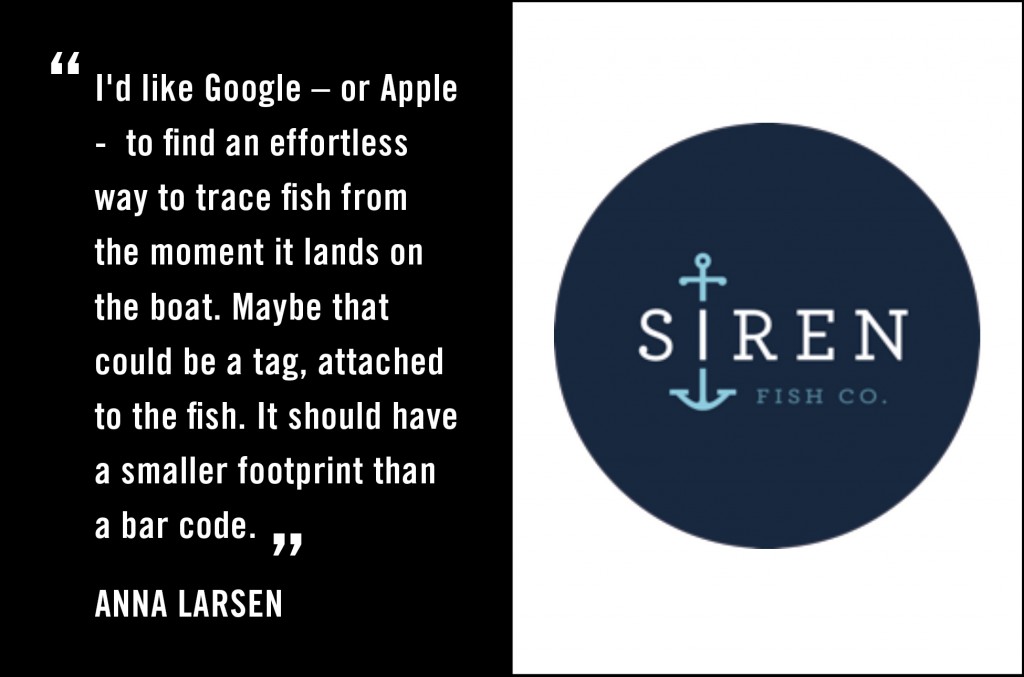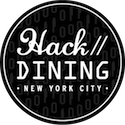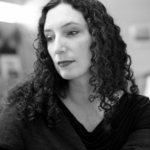Guest post by Haven Bourque, Principal, haven b media. The views expressed here are solely those of the author and do not reflect the views of Food+Tech Connect.
Haven Bourque interviews sustainable seafood pioneer Anna Larsen of Siren Fish Co., a Community Supported Fishery delivering sustainably caught seasonal fish from small local fisheries to 500 customers in the San Francisco Bay Area. When not running HavenBMedia, her communications business, Haven is an enthusiastic Siren Fish Co. drop site host for her Oakland CA neighborhood. She never tires of convincing people to eat wild American seafood, not too much, mostly filter feeders. Her favorite seafood? ‘Whatever’s in season.’
Q: Seafood is a hot button issue. 86% of seafood consumed by Americans is imported, and, as Paul Greenberg noted in a NYTimes Op-Ed this week, a third of our wild-caught American seafood is sold abroad. I know you’re working hard to change that, Anna. Tell me what technology’s magic does for your Community Supported Fishery business, SirenSeaSA.
A: Fish is complicated. First, a little background on how my business functions: I’m working with a wild product caught at sea for the most part, which involves many variables, so I need a really reliable way to track the fish from dock to the customer. I rely heavily on my CSA management software for planning share contents and managing my buying. For example, salmon season recently opened. Sustainable salmon fishing involves many small-sized boats landing a variable number of fish per boat. That means that tracking individual fish at the docks is a challenge. As a comparison, Dungeness crabs are much simpler: one boat can haul in 10,000 pounds of crab, so there’s only one boat offloading at the dock, which makes tracking fairly straightforward. But with salmon, I might buy from as many as 10 boats each day. That makes tracking which boat caught which fish really I must give the dock personnel specific instructions to make sure the fish gets into the bin labeled ‘Siren’ before it’s taken to the processing plant. Otherwise, all salmon gets thrown in together to be taken from the dock to the processing plant. Once it’s at the plant, it’s really hard to trace it. My business relies on being able to tell the customers where the fish was caught, by which method, and in many cases by which boat. My CSA software allows me to accurately plan my buying, which makes it possible for me to leave specific handling instructions at the dock well in advance.
And more: My CSA software, created by Farmigo, can tell me how many pounds of finished fish I need to fill my customer orders one day in advance. For example, this week I needed 500 lbs of salmon fillet on Thursday. I know that a whole salmon has a 70% yield, so I know how much fish I need to cut on Wednesday to fulfill on Thursday.
Before I had the software, I did a six-week trial run with no tracking system; I manually entered the date into an Excel spreadsheet, which took hours. At the time, I had only 30 customers; now I have close to 500 people and 20 drop sites. That would mean a 40-hour week just to enter the data. I love that my software does bookkeeping and customer contact, too.
Q: What obstacles has technology helped you overcome?
A: Seafood processing is messy! Carrying paper into a fish processing plant is the last thing in the world a sane person would want to do. A stack of papers with tracking information inevitably ends up all covered with blood, wet fish scales and fish guts, because that’s what’s flying through the air! So my smartphone, equipped with software, saves me. Before I arrive at the processing plant, I’ve already uploaded the software with quantities today’s fish or payment information. I pull the phone out of my pocket, make a few clicks to save the information, and I can put it back safely in my pocket, it doesn’t get covered with blood and guts.
Q: What one thing do you wish that general consumers understood about what it takes to get local, sustainable seafood from dock to door, that people clearly don’t understand yet?
A: Just how unpredictable seafood supply is. It’s the only industry I know in which you’re dealing with a wild product that is being routed through a commercial processing channel. Beef or poultry has a steady supply, with little variation in species or sizes: not so with fish. Some people don’t understand why we supply one specific fish – say rockfish – for three months. It’s because that fish is in season, and therefore it’s what the fishing boats bring in. On the other hand, seasonality means challenges even with very popular fish. When crab season starts, everyone is so excited about Dungeness crab. It’s a big money maker, so all fishing boats go out to get it. All the small operations turn their focus to crabs there’s a lot of money to be made in November, December. By February, everyone will be tired of crab. So I dig my heels in and don’t offer my subscribers crab every week early in the season, because after four months, everyone’s tired of it. Then eventually crab season tapers out. There’s a dead space in March and April, when fisheries begin re-tooling their boats for salmon season. So that’s a good time for oyster lovers; except that in a normal year, it would rain a lot during March and April, and guess what? Oyster farms shut down when there’s a lot of rain. That’s just a snapshot of how unpredictable the seafood supply can be. If we’re going to make the seafood dining experience more sustainable, seafood lovers just have to learn to love the any fish we can manage to bring into the dock.
Q: That’s been my experience too as a SirenSeaSA host in my Oakland neighborhood. Most subscribers are enthusiastic about the salmon, the halibut, and the crab, but in truth they struggle to prepare herring, sardines, and oysters.
A: Right. I do think that chefs are working their magic with some of the smaller fish; sardines are still all the rage, so that’s good news. Chefs have such influence, and there’s always a chance that a restaurant dish will inspire a home cook to heights of bravery.
Q: If you were the head honcho at Google, what dream project would you have your empire focus tackle to transform the seafood dining experience?
A: My dream question! A lot of software programs track seafood from boat to plate; TraceRegister and others. But to ensure that tracking really happens, we all still rely on boots on the ground. And I do mean rubber boots on the ground, on the dock, the second the boat pulls in: it only takes one second of an uninformed or rushing person switching the fish bins, and I’m longer telling the truth about which boat caught what. Fish get switched a lot more than we’d wish; not always intended deceit; but when it’s 4 am, pitch dark, and pounding rain…or, it’s 2 pm, and you’ve been on the dock since 4 am, in the pounding rain, it’s not uncommon to make an error. So I’d like Google – or Apple – to find an effortless way to trace fish from the moment it lands on the boat. Maybe that could be a tag, attached to the fish. It should have a smaller footprint than a bar code. It should also not be intrusive to the process of cutting up the fish, so it would have to be something permanent and difficult to remove. Like a scan tag – that was attached to all different parts of the fish! C’mon, if we can solve urban transport with Uber and Lyft, can’t we solve fish tracking?
Q: Who are your fish heroes? Do any of them live on social media, or use technology in a way that you admire?
A: My favorite person in the fish business is the head of the processing plant I use: Tony Rivas. He knows everything, and has really practical knowledge. He doesn’t even know how to turn a computer on. But he knows fish! And he’s retiring soon. For thought leadership, I love Paul Greenberg’s writing, and his Twitter presence at @4FishGreenberg.
Hacking Dining is online conversation exploring how we might use technology and design to hack a better future for dining. Join the conversation between June 2-30, and share your ideas in the comments, on Twitter using #hackdining, Facebook, LinkedIn or Tumblr.
_________________
Haven has 18 years in communications, working with diverse organizations ranging from prestigious non-profits to small start-up businesses, large corporations and individuals working on food systems, health and wellness, sustainable seafood and social justice. In her early career, she spent 10 years honing her skills in corporate marketing at international computer companies, launching groundbreaking new technologies that enabled multimedia in Europe and Asia – a sea change from her upbringing on her family’s self-sustaining organic farm.





